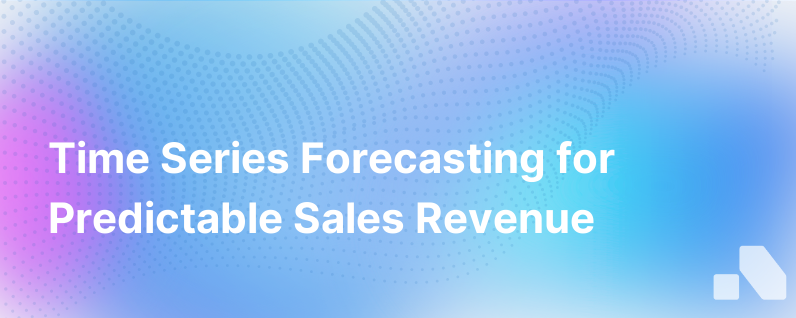Time Series Sales Forecasting Predictable Revenue
Published on October 10, 2023 by Sawyer Middeleer
In today's fast-paced business environment, achieving a predictable revenue stream is akin to finding the Holy Grail. It is the cornerstone for strategic planning, astute decision-making, and ultimately, the sustainable growth of an organization. Businesses often deploy an array of forecasting methodologies, but one that stands out for its precision and reliability in predicting future sales is Time Series Sales Forecasting.
Understanding Time Series Sales Forecasting
Time series analysis involves using historical sales data to predict future performance. This forecasting model is predicated on the assumption that past patterns are likely to continue into the future. By meticulously analyzing the data for trends, seasonal variations, cyclical patterns, and other revealing characteristics, leaders can forecast sales with greater accuracy.
The Importance of Accuracy in Sales Predictions
The ramifications of an inaccurate sales forecast can reverberate across the entire organization:
- Inventory Mismanagement: Underestimating demand can lead to stockouts, lost sales, and customer churn, while overestimating can cause excess inventory and increased holding costs.
- Budgeting Woes: Without reliable forecasts, allocating resources for marketing, R&D, and new hires becomes a game of guesswork.
- Investor Relations: Shareholders and investors expect stable and predictable returns, something that a variable revenue stream jeopardizes.
- Cash Flow Complications: Accurate forecasts enable better cash flow management and help avoid cash crunches that can cripple operations.
The Mechanics of Time Series Forecasting
The process entails identification of patterns such as trends, which indicate a long-term increase or decrease in data; seasonality, which reflects predictable and recurring short-term cycles; and random noise, which accounts for irregular variances.
Contemporary time series models incorporate:
- Moving Averages: Useful for smoothing out short-term fluctuations and highlighting longer-term trends.
- Exponential Smoothing: Assigns exponentially decreasing weights to older observations.
- ARIMA (AutoRegressive Integrated Moving Average): A sophisticated model that describes the autocorrelations in data.
These models have evolved with advancements in machine learning, allowing for enhanced predictive qualities.
Integrating External Data
While traditional time series models focus on internal sales data, integrating external datasets such as economic indicators, market trends, and consumer sentiment can significantly improve forecasting models.
Advancements in Predictive Modeling
Technological strides have led to the integration of AI and machine learning in sales forecasting. Solutions such as Aomni harness these technologies, analyzing vast datasets to predict sales outcomes with astonishing accuracy.
Machine Learning's Edge
Machine learning algorithms can discern complex patterns that are not apparent to the human eye. By training on historical sales data, these algorithms can adapt to changing trends, seasonal effects, and economic shifts, offering a dynamic and continually improving forecasting model.
From Reactive to Proactive
Leveraging predictive analytics tools, businesses transform from reactive entities to proactive ones. Armed with reliable forecasts, they can anticipate market movements, customer behavior changes, and the impact of global events on sales.
Achieving Predictable Revenue Through Forecasting
To harness the full potential of time series sales forecasting, businesses should adopt these practices:
- Data Integrity: Ensure data quality by continuously cleansing and validating sales data for accuracy.
- Regular Model Updates: Update predictive models regularly to adapt to the latest trends and patterns.
- Tailored Models: Use nuanced models sensitive to the specific trends and cycles of your industry.
- Skilled Analysts: Employ or train data analysts proficient in contemporary forecasting methodologies.
- Software Tools: Invest in sophisticated software that integrates machine learning for real-time forecasting.
Case Study: Forecasting for Growth
Imagine a SaaS company employing time series forecasting to predict quarterly revenues. By analyzing historical sales trends, seasonal purchase behaviors, and correlating these patterns with external economic indicators, the company refines its forecasting model so that it anticipates dips and spikes in demand, optimizes staff allocation, and manages its cash flow scrupulously.
The Future of Forecasting
The future of sales forecasting is one of deeper integration with AI and machine learning. As businesses accumulate more comprehensive datasets, predictive models will become even more nuanced and precise.
Potential advancements include:
- Real-Time Analytics: As machine learning capabilities progress, real-time updating of sales forecasts will become standard, allowing businesses to respond instantaneously to market changes.
- Predictive Personalization: Forecasting at the individual customer level will enable more personalized sales strategies.
- Scenario Planning: Advanced forecasting techniques may allow businesses to simulate a range of market conditions, helping them prepare for various eventualities.
- Integrative Software Solutions: Forecasting software like Aomni not only predicts sales but also offers actionable insights, competitive analysis, and personalized sales content creation, all serving to bolster the predictive sales capacity of businesses.
Conclusion
Time series sales forecasting is not merely a crystalline lens through which future sales can be glimpsed—it is the foundation upon which robust, reliable, and resilient revenue growth is built. For organizations striving toward the summit of predictable revenue, embracing sophisticated forecasting models, and leveraging the latest in AI and machine learning technology, offers a path laden with strategic foresight and enlightened decision-making. Keeping abreast of advancements in predictive analytics and maintaining a repository of clean, comprehensive sales data is paramount for companies eager to excel in the dynamic landscape of business today and tomorrow.
Predictable revenue isn't just a target; it's a competitive edge that can be honed through diligent application of time series sales forecasting—an edge that can be sharpened by embracing innovations like Aomni, engineered to amplify your sales forecasting accuracy and revenue predictability.